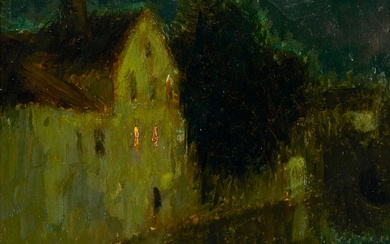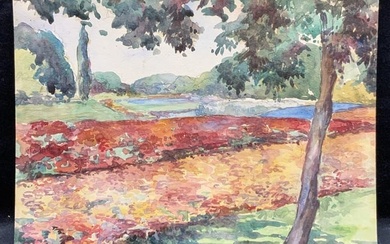Henri Le Sidaner, (1862-1939)
Matin doré
Matin doré
signed 'Le Sidaner' (lower left)
oil on canvas
73 x 60.3cm (28 3/4 x 23 3/4in).
Painted in 1920
Provenance
Galerie Georges Petit, Paris, nos. 4818 & 21 998.
Private collection, Roubaix (by the early 1920s).
Thence by descent; their sale, Christie's, Paris, 25 March 2014, lot 3.
Private collection, Paris (acquired at the above sale).
Exhibited
Pittsburgh, Carnegie Institute, Twentieth Annual International Exhibition of Paintings, 28 April - 30 June 1921, no. 192.
Literature
Y. Farinaux-Le Sidaner, Le Sidaner, L'oeuvre peint et gravé, Milan, 1989, no. 452 (illustrated p. 178).
Painted in 1920 Matin doré demonstrates Henri Le Sidaner's exceptional talent in conveying the optical effects of colour and light. The varying manifestations of light, reflecting on a surface or filtering through the natural environment, was a key preoccupation for the artist throughout his career, so much so that he would advise his students that 'no landscape was worth painting if it was not enhanced by some play of light' (R. Le Sidaner, 'How I saw the painter Le Sidaner' in Y. Farinaux-Le Sidaner, Le Sidaner L' uvre Peint et Gravé, Paris, 1989, p. 9). The present work stands as a fine example of such an atmosphere, depicting the corner of a charming village gently illuminated by the sunrise. Building the composition through a dazzling array of warm and cool tones, the artist adeptly conveys the dappled effects of the golden beams as they play across the surface of the buildings and the meandering river, capturing the transience of the sunlight as it casts its rays into the nocturnal gloom. The renowned art critic Camille Mauclair termed this enchanted moment of the day as 'Le Sidaner's time'. A brief period, be it the morning or evening twilight, in which light has the exceptional power to create this shimmering effect (R. Le Sidaner, ibid, p. 9).
Matin doré displays the characteristics of an Impressionist painting, almost bordering on Pointillism. In 1882 Le Sidaner began his studies at the Ecole des Beaux-Arts in Paris, however he soon rejected his academic training and began to follow the Impressionists. He was particularly drawn to the works of Claude Monet, whom he met several times, and his magnificent paintings of garden scenes at Giverny. Le Sidaner himself designed his own garden on a property in 1901 that he purchased in the sleepy little town of Gerberoy in Northern France. The garden was the setting to which he would frequently return for inspiration, however, as his son Rémy Le Sidaner recalled, 'Henri Le Sidaner was not always true to reality', the beautiful rosebushes and ponds of the garden were often recombined on the canvas to suit the compositional whims of the painter: 'When my father caught one of these 'special effects', he nodded in my direction and stood there, gazing out towards the horizon, impressing on his mind the scene he had just witnessed. The drawing was copied out any time of the day and transferred to the canvas' (R. Le Sidaner, ibid, p.10).
Although Le Sidaner never called himself an Impressionist, he found that certain aspects and techniques suited him perfectly to render the brief moments of luminosity in the natural world upon the canvas. Selecting and combining his favourite compositional devices, Le Sidaner invented his own version of Impressionism, to which he would remain faithful throughout his life. According to Rémy Le Sidaner, 'his painting technique changed very little after 1900... A number of art critics claimed that Henri Le Sidaner was unaware of the great changes that had occurred in European painting at the beginning of the twentieth century. That was not the case. He had found his way in life and had decided that he would not stray from it' (R. Le Sidaner, ibid, p. 17)
A decisive moment in Le Sidaner's career was his two-year stay in Bruges. It was here within the magic of the mediaeval city with its many canals and Nordic atmosphere 'that he developed his personal brand of melancholy', and many of his subsequent works appear to be a nostalgic reinterpretation of its historic streets (L. Gascoigne, 'Henri Le Sidaner: The Artist Who Fell Between Two Schools', The Spectator, 10 May 2014).
In Bruges he became acquainted with the works of Emil Claus, whose exquisite light effects created by his skilled play of colour and brushstroke, profoundly influenced Le Sidaner's style. For instance in Across the Canal from 1900, the impact that the Belgian artist had on Le Sidaner is clearly visible, notably in the chosen colour palette and opalescent light which shimmers on the water. However, whereas Claus' painting features people strolling down the canal, and the houses are clearly inhabited, Matin doré seems silent and almost deserted, as if it were a melancholic memory from the past re-imagined on the canvas. The artist's oeuvre clearly reveals that since his period in Bruges the appearance and interaction of human beings seemed to be almost irrelevant in comparison to his main preoccupation in reproducing optical plays of colour and light on the canvas. Indeed, as Paul Signac noted, Le Sidaner's 'entire work is influenced by a taste for tender, soft and silent atmospheres. Gradually, he even went so far as to eliminate from his paintings all human figures, as if he feared that the slightest human form might disturb their muffled silence' (P. Signac quoted in Y. Farinaux-Le Sidaner, Le Sidaner L'oeuvre peint et gravé, Milan, 1989, p. 31).
View it on
Sale price
Time, Location
Auction House
Matin doré
Matin doré
signed 'Le Sidaner' (lower left)
oil on canvas
73 x 60.3cm (28 3/4 x 23 3/4in).
Painted in 1920
Provenance
Galerie Georges Petit, Paris, nos. 4818 & 21 998.
Private collection, Roubaix (by the early 1920s).
Thence by descent; their sale, Christie's, Paris, 25 March 2014, lot 3.
Private collection, Paris (acquired at the above sale).
Exhibited
Pittsburgh, Carnegie Institute, Twentieth Annual International Exhibition of Paintings, 28 April - 30 June 1921, no. 192.
Literature
Y. Farinaux-Le Sidaner, Le Sidaner, L'oeuvre peint et gravé, Milan, 1989, no. 452 (illustrated p. 178).
Painted in 1920 Matin doré demonstrates Henri Le Sidaner's exceptional talent in conveying the optical effects of colour and light. The varying manifestations of light, reflecting on a surface or filtering through the natural environment, was a key preoccupation for the artist throughout his career, so much so that he would advise his students that 'no landscape was worth painting if it was not enhanced by some play of light' (R. Le Sidaner, 'How I saw the painter Le Sidaner' in Y. Farinaux-Le Sidaner, Le Sidaner L' uvre Peint et Gravé, Paris, 1989, p. 9). The present work stands as a fine example of such an atmosphere, depicting the corner of a charming village gently illuminated by the sunrise. Building the composition through a dazzling array of warm and cool tones, the artist adeptly conveys the dappled effects of the golden beams as they play across the surface of the buildings and the meandering river, capturing the transience of the sunlight as it casts its rays into the nocturnal gloom. The renowned art critic Camille Mauclair termed this enchanted moment of the day as 'Le Sidaner's time'. A brief period, be it the morning or evening twilight, in which light has the exceptional power to create this shimmering effect (R. Le Sidaner, ibid, p. 9).
Matin doré displays the characteristics of an Impressionist painting, almost bordering on Pointillism. In 1882 Le Sidaner began his studies at the Ecole des Beaux-Arts in Paris, however he soon rejected his academic training and began to follow the Impressionists. He was particularly drawn to the works of Claude Monet, whom he met several times, and his magnificent paintings of garden scenes at Giverny. Le Sidaner himself designed his own garden on a property in 1901 that he purchased in the sleepy little town of Gerberoy in Northern France. The garden was the setting to which he would frequently return for inspiration, however, as his son Rémy Le Sidaner recalled, 'Henri Le Sidaner was not always true to reality', the beautiful rosebushes and ponds of the garden were often recombined on the canvas to suit the compositional whims of the painter: 'When my father caught one of these 'special effects', he nodded in my direction and stood there, gazing out towards the horizon, impressing on his mind the scene he had just witnessed. The drawing was copied out any time of the day and transferred to the canvas' (R. Le Sidaner, ibid, p.10).
Although Le Sidaner never called himself an Impressionist, he found that certain aspects and techniques suited him perfectly to render the brief moments of luminosity in the natural world upon the canvas. Selecting and combining his favourite compositional devices, Le Sidaner invented his own version of Impressionism, to which he would remain faithful throughout his life. According to Rémy Le Sidaner, 'his painting technique changed very little after 1900... A number of art critics claimed that Henri Le Sidaner was unaware of the great changes that had occurred in European painting at the beginning of the twentieth century. That was not the case. He had found his way in life and had decided that he would not stray from it' (R. Le Sidaner, ibid, p. 17)
A decisive moment in Le Sidaner's career was his two-year stay in Bruges. It was here within the magic of the mediaeval city with its many canals and Nordic atmosphere 'that he developed his personal brand of melancholy', and many of his subsequent works appear to be a nostalgic reinterpretation of its historic streets (L. Gascoigne, 'Henri Le Sidaner: The Artist Who Fell Between Two Schools', The Spectator, 10 May 2014).
In Bruges he became acquainted with the works of Emil Claus, whose exquisite light effects created by his skilled play of colour and brushstroke, profoundly influenced Le Sidaner's style. For instance in Across the Canal from 1900, the impact that the Belgian artist had on Le Sidaner is clearly visible, notably in the chosen colour palette and opalescent light which shimmers on the water. However, whereas Claus' painting features people strolling down the canal, and the houses are clearly inhabited, Matin doré seems silent and almost deserted, as if it were a melancholic memory from the past re-imagined on the canvas. The artist's oeuvre clearly reveals that since his period in Bruges the appearance and interaction of human beings seemed to be almost irrelevant in comparison to his main preoccupation in reproducing optical plays of colour and light on the canvas. Indeed, as Paul Signac noted, Le Sidaner's 'entire work is influenced by a taste for tender, soft and silent atmospheres. Gradually, he even went so far as to eliminate from his paintings all human figures, as if he feared that the slightest human form might disturb their muffled silence' (P. Signac quoted in Y. Farinaux-Le Sidaner, Le Sidaner L'oeuvre peint et gravé, Milan, 1989, p. 31).





